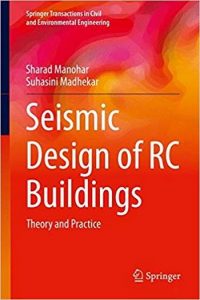نام کتاب: Seismic Design of RC Buildings – Theory and Practice
نویسنده: Sharad Manohar و Suhasini Madhekar
ویرایش: ۱
سال انتشار: ۲۰۱۵
فرمت: PDF
تعداد صفحه: ۴۵۰
کیفیت کتاب: OCR
انتشارات: Springer
Description About Book Seismic Design of RC Buildings – Theory and Practice From Amazon
This book is intended to serve as a textbook for engineering courses on earthquake resistant design. The book covers important attributes for seismic design such as material properties, damping, ductility, stiffness and strength. The subject coverage commences with simple concepts and proceeds right up to nonlinear analysis and push-over method for checking building adequacy. The book also provides an insight into the design of base isolators highlighting their merits and demerits.
Apart from the theoretical approach to design of multi-storey buildings, the book highlights the care required in practical design and construction of various building components. It covers modal analysis in depth including the important missing mass method of analysis and tension shift in shear walls and beams. These have important bearing on reinforcement detailing. Detailed design and construction features are covered for earthquake resistant design of reinforced concrete as well as confined and reinforced masonry structures. The book also provides the methodology for assessment of seismic forces on basement walls and pile foundations. It provides a practical approach to design and detailing of soft storeys, short columns, vulnerable staircases and many other components. The book bridges the gap between design and construction. Plenty of worked illustrative examples are provided to aid learning. This book will be of value to upper undergraduate and graduate students taking courses on seismic design of structures.
درباره کتاب Seismic Design of RC Buildings – Theory and Practice ترجمه شده از گوگل
این کتاب در نظر گرفته شده است که به عنوان کتاب درسی برای دوره های مهندسی طراحی مقاوم در برابر زلزله خدمت کند. این کتاب ویژگی های مهمی برای طراحی لرزه نگاری مانند خواص مواد ، میرایی ، شکل پذیری ، سفتی و مقاومت را در بر می گیرد. پوشش موضوع با مفاهیم ساده آغاز می شود و درست از طریق تحلیل غیرخطی و روش فشار برای بررسی کفایت ساختمان پیش می رود. این کتاب همچنین بینشی از طراحی ایزولاسیون های پایه را نشان می دهد که شایستگی ها و کمبودهای آنها را برجسته می کند.
جدای از رویکرد نظری برای طراحی ساختمانهای چند طبقه ، این کتاب مراقبت های لازم در طراحی عملی و ساخت اجزای مختلف ساختمان را برجسته می کند. آن را شامل می شود تجزیه و تحلیل معین در عمق از جمله مهم توده از دست رفته تجزیه و تحلیل و تغییر تنش در دیوارهای برشی و پرتوهای. اینها نقش مهمی در جزئیات آرماتور دارند. طراحی و ساخت و سازهای تفصیلی از آن برای طراحی مقاوم در برابر زلزله بتن آرمه و همچنین سازه های سنگ تراشی محدود و تقویت شده پوشانده شده است. این کتاب همچنین روش ارزیابی نیروهای لرزه ای روی دیوارهای زیرزمین و پایه های شمع را ارائه می دهد. این یک رویکرد عملی برای طراحی و جزئیات از طبقه های نرم ، ستون های کوتاه ، پله های آسیب پذیر و بسیاری از اجزای دیگر را فراهم می کند. این کتاب شکاف بین طراحی و ساخت را نشان می دهد. بسیاری از نمونه های مصور کار شده برای کمک به یادگیری ارائه شده است. این کتاب برای دانشجویان فوق لیسانس و کارشناسی ارشد که دوره هایی در زمینه طراحی لرزه نگاری سازه ها می گذرانند دارای ارزش خواهد بود.
[box type=”info”]![]() جهت دسترسی به توضیحات این کتاب در Amazon اینجا کلیک کنید.
جهت دسترسی به توضیحات این کتاب در Amazon اینجا کلیک کنید.![]() در صورت خراب بودن لینک کتاب، در قسمت نظرات همین مطلب گزارش دهید.
در صورت خراب بودن لینک کتاب، در قسمت نظرات همین مطلب گزارش دهید.
[tabs slidertype=”simple” auto=”yes”] [tab]
دسته های پرطرفدار دانلود کتاب عمران
- دانلود کتاب مهندسی سازه
- دانلود کتاب سازه فولادی
- دانلود کتاب سازه بتنی
- دانلود کتاب تحلیل سازه
- دانلود کتاب مهندسی زلزله
- دانلود کتاب مکانیک سیالات
- دانلود کتاب هیدرولیک
- دانلود کتاب هیدرولوژی
- دانلود کتاب مکانیک خاک
- دانلود کتاب مهندسی پی و ژئوتکنیک
- دانلود کتاب راهسازی
- دانلود کتاب روسازی
- دانلود کتاب مدیریت پروژه
[/tab] [/tabs]

